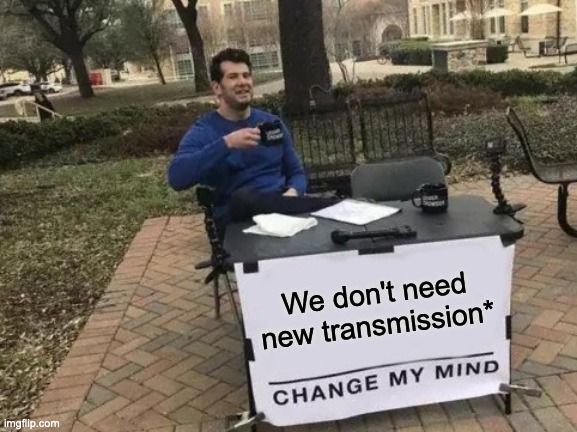The climate advocacy and clean energy community are far too focused on new power lines, whereas we have faster, cheaper, and more efficient tools to meet many of our collective goals. In a recent Twitter thread, I shared an inflammatory meme to suggest we don’t need new high-voltage transmission lines. I’d describe my position as this: I’m a grid capacity believer, but a transmission skeptic.

Transmission lines are slow and expensive to build. New high-voltage power lines in the Midwest have been averaging 10 to 12 years from concept to completion in recent years. The lines that add the most power also cost the most. A double-circuit 345 kilovolt line costs over $3 million per mile. This 345 kV power line could connect up to 800 megawatts of new power generation and carry it 110 miles. A 765 kV single-circuit transmission line could carry over 2,200 megawatts a distance of 550 miles, but at a price of $5 million per mile.
Most of the goals we want transmission to achieve can be met by alternatives. Building new transmission lines is one of the least efficient ways to fulfill needs like adding capacity to a congested area or shoring up grid reliability. It is often slower or more costly than alternatives to add capacity for new renewable energy. The planning process for transmission doesn’t usually evaluate those alternatives. For example, we can get a lot more transmission capacity by using existing wires more efficiently or upgrading existing infrastructure –– here are three opportunities:
-
Grid enhancing technologies
Grid enhancing technologies such as dynamic line ratings and topology control software can expand grid capacity significantly (40%!) in a timeframe and payback period of months. U.S. utilities rarely use them.
-
Reconductoring
Transmission lines can also be upgraded – or “re-conductored” in the industry lingo – by putting new, higher capacity wires on the same tower. As discussed in a recent Volts podcast, reconductoring can expand the capacity of existing wires by two to three times, and at a fraction of the cost of building entirely new ones. We don’t hear much about reconductoring because our grid capacity studies for reducing carbon emissions do not model this cost-effective strategy, but rather assume most new capacity comes from new towers and power lines.
-
Distributed energy generation
We can also reclaim transmission capacity by building generation that serves local needs. Wind-solar hybrids and distributed clean energy resources can serve the low-voltage side of substations and free up existing transmission capacity. Virtual power plants can serve local load and reduce peak demand, reducing transmission import capacity to cities and other load centers. Saul Griffith, inventor and renewable energy advocates, says local solar can serve 50%+ of needs in an electrified economy. The Local Solar for All study famously found that optimizing our use of distribution energy would lower the cost of achieving a low-carbon electricity system by nearly half a trillion dollars. Most of these distributed energy solutions deploy faster and as cost-effectively as any large clean energy projects.
It’s important to note that the distributed energy solutions to a clean grid also offer much more in terms of local economic benefits and equitable distribution of those benefits. There aren’t community-owned transmission lines, but there are lots of rooftop and community solar projects delivering substantial financial benefits to communities, including those who have been historically subject to the worst pollution and highest energy burdens of the fossil fuel economy.
Given how slow and expensive it is to deploy new transmission, we need to focus on using it in the places that other faster and cheaper technology cannot serve. All of the alternatives –– grid-enhancing technologies, reconductoring, distributed energy –– deploy at a fraction of the cost and in a fraction of the time required to build new power lines. Being a grid capacity believer means I want us to rapidly invest in the grid to make it capable of delivering clean, local power equitably – and building new transmission is often not the most effective way to do it.
While I’m very clear that we undervalue transmission alternatives due to the interests of incumbent utilities, I’m still very open-minded about some caveats raised by Simon Mahan, Executive Director of Southern Renewable Energy Association, in response to my Twitter thread:
- Regional interconnection –– imagine Minnesota in 2040, hopefully a state where heat pumps have overwhelmingly been adopted making the state very reliant on winter electricity production. Winter solar output in Minnesota is very low (I have solar; I’ve seen it). What happens on a windless, icy cold night when electric demand is high? In this case, it seems like regional transmission may be the best tool (and certainly as likely as massive, long duration storage) to get Minnesotans through the cold.
- Windy places –– Simon notes that the sites of existing fossil fuel power plants may not be the best places for new renewable energy projects. That’s probably not true for solar, unless these power plant sites are heavily wooded, but it may be true for wind power or geothermal where the resource quality is more site specific.
- Cost and benefit –– Simon notes that evaluations of power line projects may show strong cost-benefits balances, based on reducing grid electricity prices. Compared to what, however? Most transmission cost-benefit studies do not examine non-transmission alternatives.
In an honest desire to address climate change quickly, we have too great a focus on power lines at the expense of many approaches to expanding grid capacity. If you are pro-transmission without also supporting serious structural reform of our transmission planning and building process, without prioritizing upgrades to existing wires and distributed energy, then you aren’t serious enough about unlocking the fastest and most affordable solutions to climate change.
This article originally posted at ilsr.org. For timely updates, follow John Farrell on Twitter, our energy work on Facebook, or sign up to get the Energy Democracy weekly update.
Featured Photo Credit: iStock




